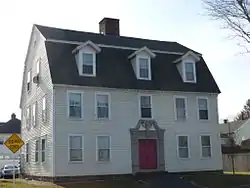Landlord Fowler Tavern
The Landlord Fowler Tavern is a historic tavern in Westfield, Massachusetts. Probably built in the 1750s, it is a good local example of Georgian architecture, and it was for about a century an important local social gathering point, and a major stop on the east-west stagecoach road. Now a private residence, it was listed on the National Register of Historic Places in 1982.[1]
Landlord Fowler Tavern | |
 | |
  | |
| Location | 171 Main St., Westfield, Massachusetts |
|---|---|
| Coordinates | 42°7′3″N 72°44′10″W |
| Built | c. 1755 |
| Architectural style | Georgian |
| NRHP reference No. | 82001914[1] |
| Added to NRHP | August 11, 1982 |
Description and history
The former Landlord Fowler Tavern stands east of downtown Westfield, on the south side of Main Street (United States Route 20, a major route through the Berkshires to the west). It is set a short way west of the confluence of the Little River with the Westfield River, at the southwest corner of Main and Exchange Streets. It is a three-story wood frame structure, with two full stories topped by a broad gambrel roof. The steep portion of the roof is pierced by three gabled dormers, and a large brick chimney rises at its center. The front facade is five bays wide, with a center entrance. The entrance is a simplified modern version of its elaborate original, with pilasters rising to a scrolled pediment; the original is in the Metropolitan Museum of Art.[2]
The building is estimated to have been built in the 1750s, or no later than 1761, the year in which Daniel Fowler was granted a license to operate a tavern in Westfield center. It was for many years a center of business and civic affairs in the town as well as a rest stop for travelers on the post road, on which it was located. During the American Revolutionary War, it served as a muster site for the local militia, and was where the local committee of safety met. Baron Friedrich Adolf Riedesel, a Hessian commander in the army of John Burgoyne, was quartered here after that army was captured at the end of the 1777 Saratoga campaign.[2]
The 1830 construction of the Hampshire and Hampden Canal led to a decline in business on the post road, and Westfield's business district eventually developed further to the west. By the 1860s the building was in use as a residence. It was used briefly as a cigar factory between 1885 and 1916.[2] Its original Georgian front door surround, a classic Connecticut River valley pediment, was removed from the building in the early 20th century.
References
- "National Register Information System". National Register of Historic Places. National Park Service. April 15, 2008.
- "MACRIS inventory record for Landlord Fowler Tavern". Commonwealth of Massachusetts. Retrieved 2013-12-07.
